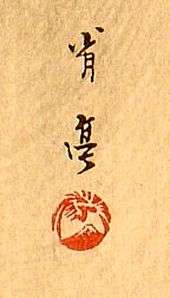Watanabe Shōtei

Watanabe Shōtei aka Watanabe Seitei (1851 in Edo – 1918) was a Nihonga painter and one of the first to visit Europe, attending the 1878 International Exhibition in Paris and being awarded a medal. Shōtei blended Western realism with the delicate colours and washes of the Kikuchi Yōsai school, introducing a new approach to kachōga or kacho (bird-and-flower painting).
Life and work
Born as Yoshikawa Yoshimata, he was later adopted by the family of his father's literary friend, Watanabe Mitsue. His early studies were at age sixteen under Kikuchi Yōsai (1788–1878) after which he spent a brief time in the studio of the painter and lacquer artist, Shibata Zeshin (1807–1891).[1]
In 1878 he travelled in the United States and Europe, remaining in Paris for three years and becoming the first Nihonga artist to live in Europe with the aim of studying Western painting.[2]
Travel abroad was extremely difficult for Japanese artists in the early Meiji period (1868–1912), and it is unknown how Shōtei managed this. A few years earlier, in 1875, he had produced designs for an export company, which may have provided him with the necessary contacts. His works have enjoyed great popularity in the West, and a large number are to be seen in both European and American collections.[3][4]

On his return from Europe, Seitei created designs for ceramics and cloisonné, working with the cloisonné artist Namikawa Sosuke (1847–1910), leading to acclaim from abroad. He maintained a prodigious output of paintings and illustrations, producing three outstanding albums: Seitei kacho gafu ('Picture album of Seitei's bird and flower'), 1890–91; Kacho gafu ('Bird and flower album'), 1903; and the last series published in 1916 also entitled Seitei kacho gafu.
Watanabe Shotei also edited and contributed to the art magazine Bijutsu Sekai (The World of Art), of which the first number was published by Wada Tokutaro in the year Meiji 23 (1890) and printed by Yoshida Ichimatsu with the blockcuts carried out by Goto Tokujiro. Besides Watanabe's illustration and that of Yoshitoshi Kyosai, there were ten other artists who contributed.[5] Twenty-two of his bird and flower prints were published by Okura Yasugorō in 1916.
During his life he received many awards, in expositions in and out of Japan. He became a major inspiration to the following generation of Nihonga artists, notably Mizuno Toshikata (1866–1908) and Kaburagi Kiyokata (1878–1973).
Gallery
Notes
- ↑ http://www.scholten-japanese-art.com/nihonga_02.htm
- ↑ Guide to Modern Japanese Woodblock Prints, 1900-1975 by Helen Merritt, Nanako Yamada
- ↑ http://www.britishmuseum.org/explore/highlights/highlight_objects/asia/w/watanabe_sh%C5%8Dtei,_swallows_on_a.aspx
- ↑ http://shotei.com/artists/shotei/biography.htm
- ↑ http://www.morra-japaneseart.com/img/prints/detail/M%20379.htm
| Wikimedia Commons has media related to Watanabe Shotei. |
References
- Conant, Ellen P.; Steven D. Owyoung and J. Thomas Rimer. (1995). Nihonga: Transcending the Past: Japanese-Style Painting, 1868-1968. St. Louis, Missouri: Saint Louis Art Museum.
- Merritt, Helen and Nanako Yamada. (1995). Guide to Modern Japanese Woodblock Prints, 1900-1975. Honolulu: University of Hawaii Press. ISBN 9780824817329; ISBN 9780824812867; OCLC 247995392


